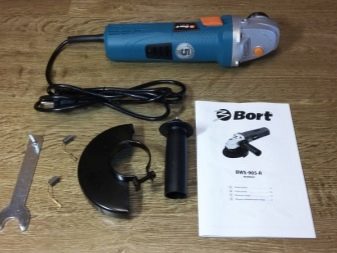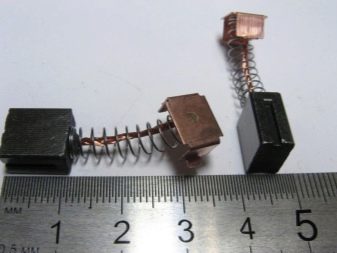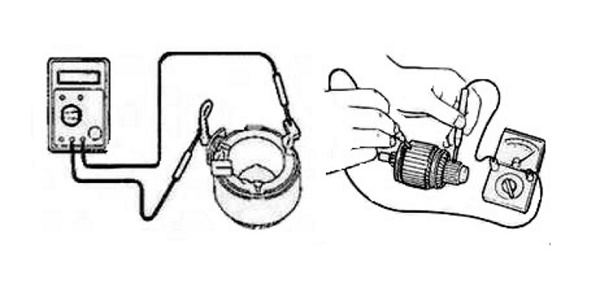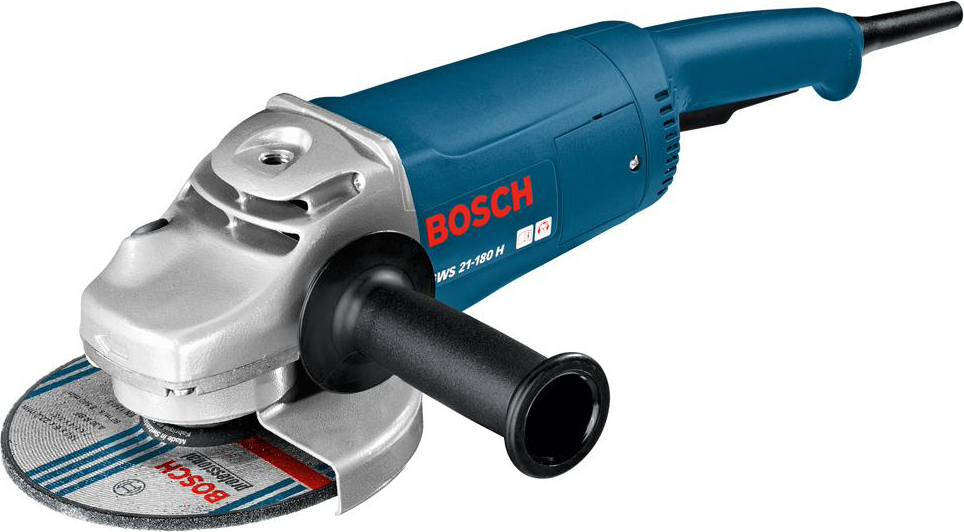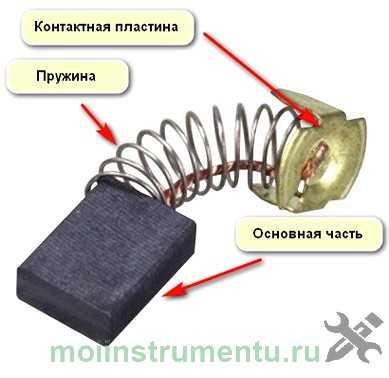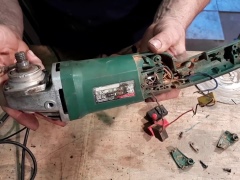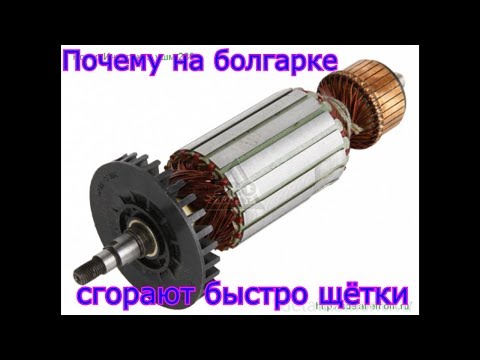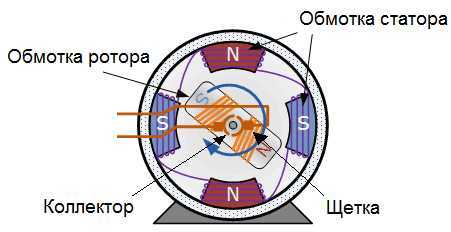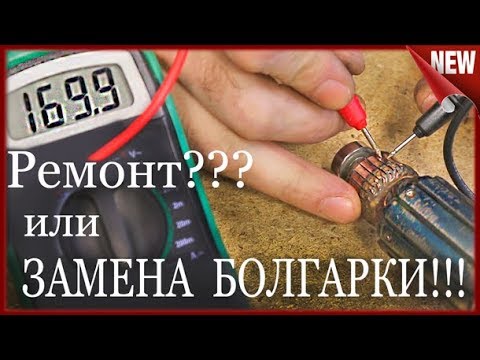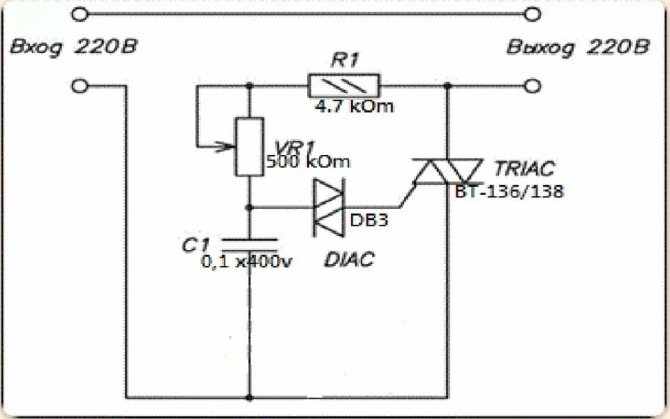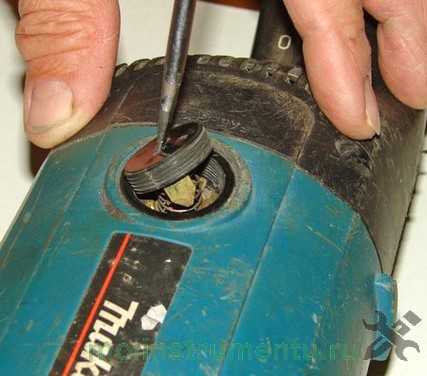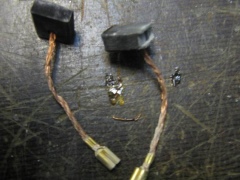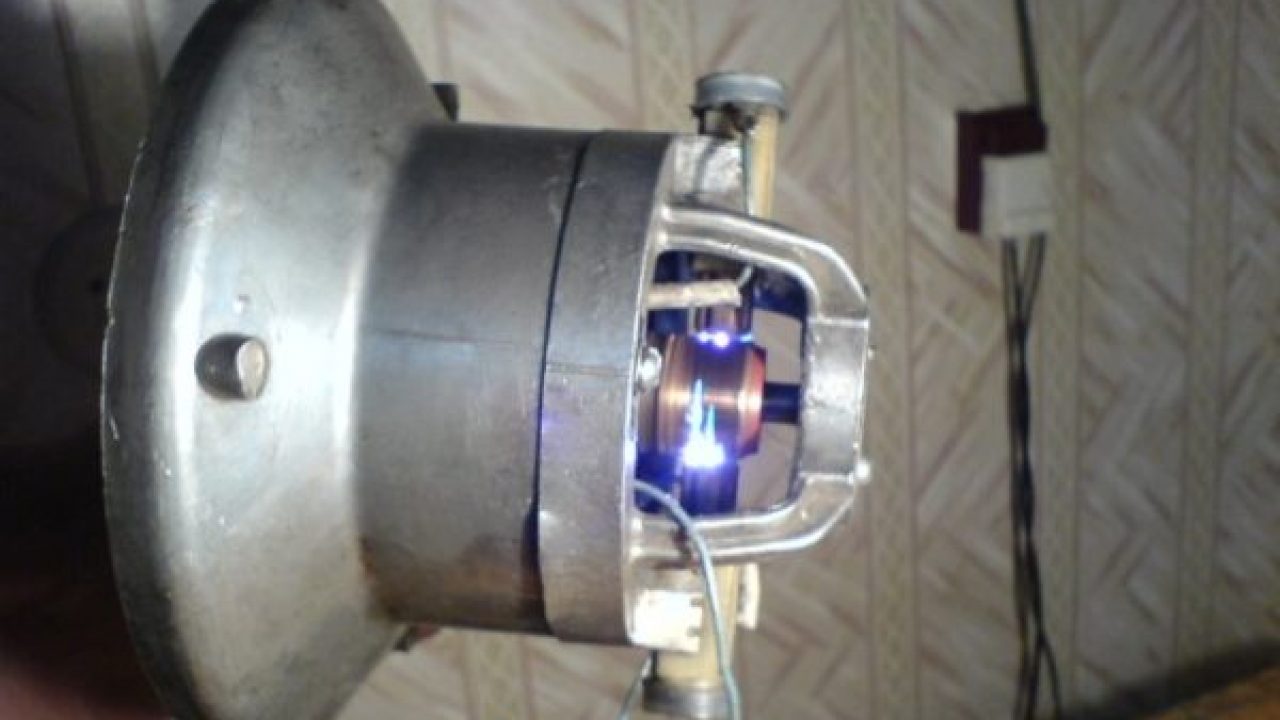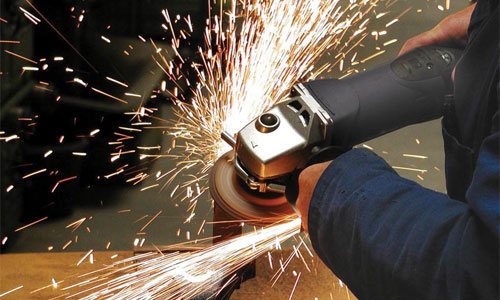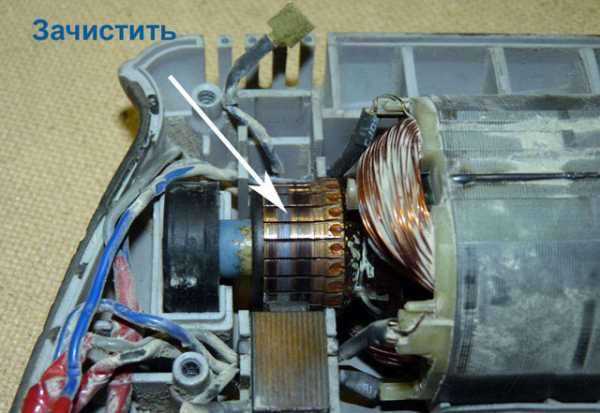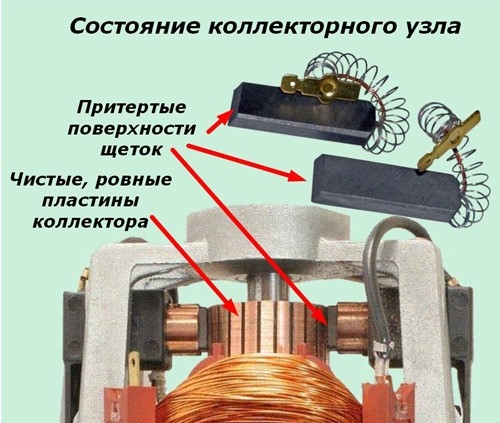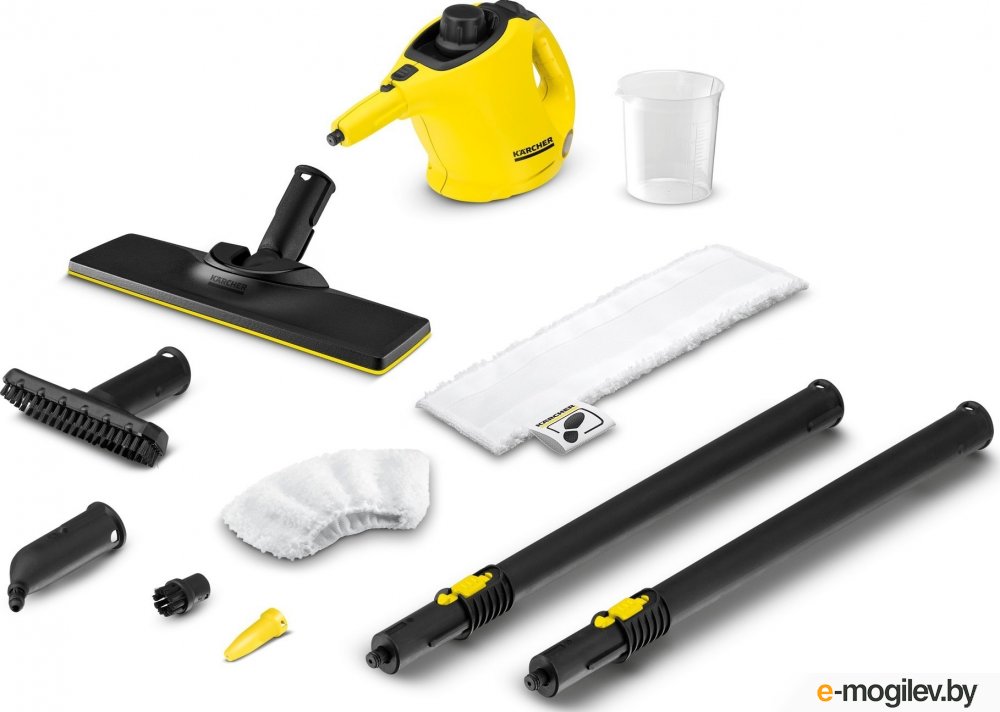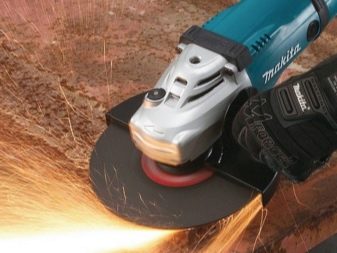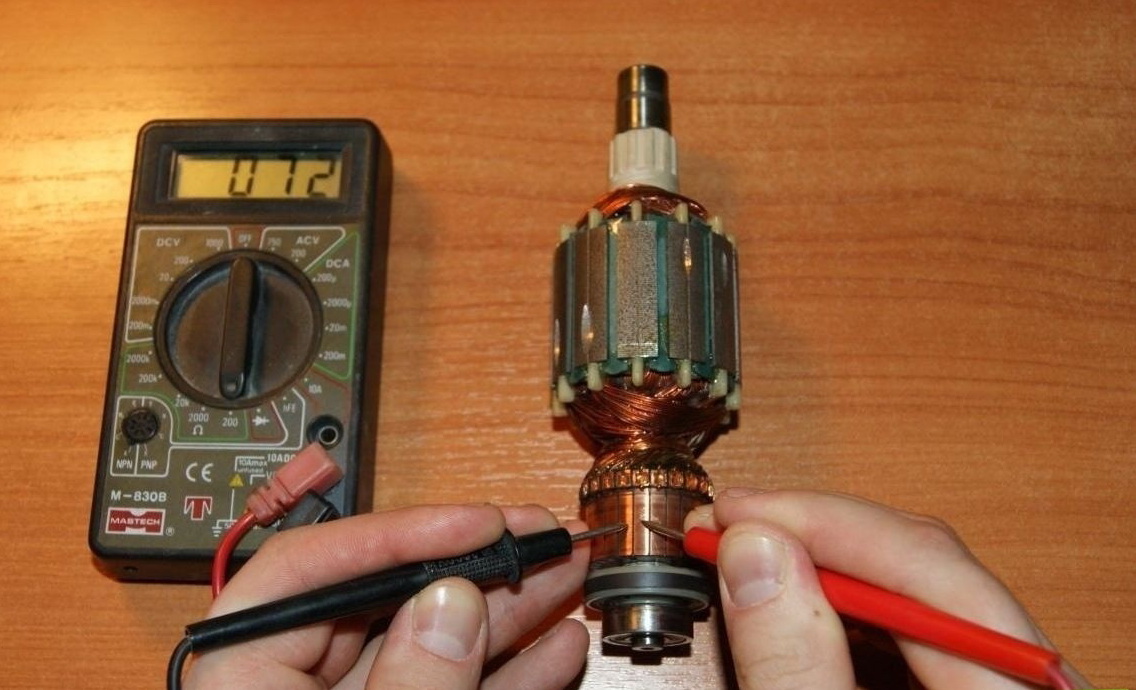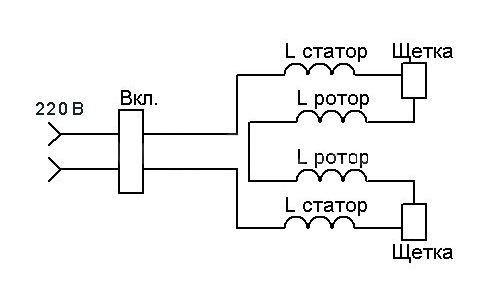The brushes of the motor of the power tool spark: the reason, they strongly spark on the anchor of the drill, the grinder

In household electrical equipment, collector motors are widely used. Small dimensions, lightness, ease of operation have led to their presence in grinders, hammer drills, circular saws, screwdrivers. The main disadvantage is increased wear of the brush-collector pair. Failure of this unit is predetermined by spark formation arising in it.
The device of the electric motor and the principle of operation
The principle of operation of an electric motor is based on the interaction of a conductor with a current in a magnetic field.
The stator creates a magnetic field.
The main element of its design for a DC motor is a permanent magnet, for an alternating current - an excitation winding. The rotor (armature) has its own winding, to which voltage is supplied with the help of a brush-collector unit. The interaction of magnetic fields makes the rotor spin.
The collector consists of a set of contacts in the form of copper plates located directly on the rotor. Micanite or mica cuffs act as insulators for each individual contact. Graphite brushes - sliding contacts pressed against the collector.
Causes
Transient processes occur in the rotor windings due to intermittent mechanical contact of the brushes with the collector plates, which is the cause of the formation of small arcs.
Important: a fully functional motor does not exclude sparking during operation. There are other causes of strong arcing and the potential for motor breakdown.
Wear of brushes
With prolonged use or poor-quality material of the brushes, they cease to tightly press against the contacts of the collector. Due to poor contact, the engine does not pick up speed or does not start immediately. A worn out brush is easy to identify visually.
Sometimes it is not possible to correct the situation by replacing only the worn out part. It is necessary to replace the brush holder and the spring.
Short circuit in the armature winding
The consequence of such a defect is uneven sparking on the collector. It will be stronger on some plates than on others. Due to the presence of an interturn short circuit, the current in some sections of the rotor winding will be stronger than in others.
Rewinding or replacing the rotor will fix the problem.
Malfunction in the stator winding
A defect similar to the short circuit of the rotor winding occurs for the stator winding. You can check the presence by measuring the resistance of parts of its windings. If there is a strong difference, the winding must be rewound or replaced.
Pollution
The wear product of the brushes is graphite dust, which is an additional source of increased sparking. Dust accumulates between the plates, which creates additional conditions for the spark formation process. Preventive work for cleaning the collector with sandpaper and cleaning up the dirt between the plates will keep it clean.
Brushes incorrectly installed
If the brushes are positioned abnormally towards the collector surface, significantly more graphite dust is generated during operation. Displaced brushes must be corrected.
Poor contact of the brushes with the collector
The electric motor spends part of its operating time in overheating mode. Under these conditions, carbon deposits form on the manifold. Poor contact will lead to increased spark formation from the brushes and more carbon build-up.
It is necessary to clean the collector surface with fine-grain emery paper. Use a screwdriver to increase the stripping effect.Clamp the engine rotor into the chuck and at low speeds, sandpaper to remove carbon deposits. After that, you need to finally polish it on a felt circle.
Mechanical disturbances
Mechanical reasons are caused by non-compliance with the requirements of design and technological documentation. Most of the mechanical causes are eliminated by the manifold groove on the lathe. Have this repair done by a qualified technician. Here are some types of faults that may indicate a breakdown:
- The collector surface is uneven;
- Shaft runout exceeds the value specified in the technical documentation;
- Separate collector plates extend beyond the common level for all;
- Insulation protrusion (mica);
- The brushes in the brush holders are jammed;
- On the contrary, the brushes are inserted into the brush holders with a large gap, which creates vibration during operation;
- Brush holders are installed far from the manifold;
- Uneven tension of the springs, as a result of the difference in the pressing force of the brushes.
Causes of malfunctions and methods of their elimination
Depending on which part of the drill has become unusable, repair interventions will depend. Consider the most common external signs of breakdowns.
A breakdown will be indicated when the brushes begin to spark, the drill does not develop full power, and also periodically there are problems with turning it on, and it starts working only after the application of physical force
The tool must be diagnosed, if at the end it is revealed that the capacitor is in good condition, the external integrity of the armature, and it also turns out that the resistance of the stator windings has the same resistance, then it is necessary to pay attention to the wear of the brushes
Diagram of the internal structure of the drill-screwdriver.
In order to check this moment, it is necessary to press the brushes of the drill-perforator to the anchor using a screwdriver. In this case, it must be remembered that the handle of the tool must be a dielectric, otherwise there is a possibility of getting an electric shock. If, upon contact, the drill starts to work at full power, then the whole problem is in the brushes. In this case, they must be replaced with new ones. But sometimes such a replacement does not have the desired effect, so it is recommended to change the holders as well.
Experts recommend not to wait until such a part is worn out and sometimes do a preventive inspection. The main sign of the need for replacement is increased sparking in the ventilation slots located on the case. As soon as it begins to be observed, new brushes should be prepared immediately.
If the perforator does not work fully in speed or, again, the brushes sparkle, you need to clean it. For this purpose, using sandpaper "0", the collector is cleaned in the direction in which the anchor is turning. Next, it is necessary to cut through the dielectric spacers, which are located between the collector plates. This procedure is performed using a cutter, and if possible, it is best to do the whole procedure on a lathe.
Drill chuck device diagram.
Another method can be applied. An anchor is clamped into the drill chuck, and then at low speed, pressing the sandpaper to the collector, turn it on.
The punch may not work if non-native brushes are installed on the imported model. But in the case of strong sparks, there is a possibility that the armature burned out, which is also indicated by the strong heating of the winding. Sparks can be triggered by a turn-to-turn circuit. If the drill has one of the two brushes, then the problem is most likely in the stator. It just simply burned out.
In order to make sure of this, it is necessary to measure the resistance indicators of the windings using a tester. It should show a 4 ohm mark on both elements. In the case when the indicators differ, this will be direct evidence of a stator malfunction.Then you need to start rewinding the windings.
There may also be a problem with the power wires. If the hammer drill is used intensively enough, then there is a possibility that in some place they are frayed. This may cause the drill to fail immediately. To determine the location of the breakdown, it is necessary to "ring out" the wire right up to the trigger itself. If even during diagnostics it turns out that they are in good working order, then you should check the key itself.
Damage can also happen to the motor.
In this case, you should pay attention to the armature (which is most often the case) or the stator. In models of expensive firms, a winding wire is used, which is coated with a special heat-resistant varnish
Whereas cheaper counterparts do not pay enough attention to insulation. Therefore, if such a perforator operates for a long time without interruptions, then the engine does not have time to cool down and, in the end, burns out.
The grinder is very hot
Why is the Bulgarian heated
Users browsing this forum: Google and guests: 9. Representative office of Makita in Russia. Last visited: Tue Oct 08, am Current time: Tue Oct 08, am. Moderators: Yatsenko Igor, Alexey Sitnikov.
In the absence of it, it will take a significant part of your free time, despite studying the video instructions of the masters. Experienced masters who first took up this, despite their knowledge of the theory, are not immune from unforeseen situations. Usually, this in the hands of an amateur when trying to repair in a domestic environment, leads to an increase in the cost of correcting the defect. For obvious reasons, this is not acceptable if an urgent solution is needed. Find out the real average cost and duration of the specialist's work using the example of the last completed repairs in the table below.
The manufacturer reserves the right to independently change the configuration, characteristics, country of manufacture of the goods without further notice to dealers.
Your browser does not allow the use of cookies. If you want to get unlimited access to all the site's functions, you need to enable cookies and reload the page. Add to Basket. Next day delivery. Order and pick up in 4 hours. We offer products in your selected OBI market together - you pay directly to pickup - and save time shopping.
The grinder, being the most demanded tool in the house, is subject to considerable stress and intensive use. Because of this, after some time, it happens that when the engine is started, jerks, a burning smell and other malfunctions appear, suggesting that the angle grinder of the angle grinder has broken down. But do not immediately carry the device for repair or buy a new one.
Sandpaper groove
The armature shaft is fixed in the chuck of any torque mechanism (lathe, drill). Rotation starts, the abrasive is applied to the collector. Forceful pressing and the use of coarse-grained sandpaper are excluded. The minimum grit value is 1000 P.
Using a multimeter, detect the presence of a breakdown in the armature winding. Set resistance test mode. Apply one probe to the lamella and the other to the contact of the corresponding winding track. The absence of an open circuit will be indicated by an audible signal. If there is no signal, this trace is broken. You will need to replace the armature or rewind its winding.
Determine the presence of runout in the bearings. If it is found, replace the bearings and measure with a micrometer the diameter of the edges of the armature shaft at the points of its abutment to the assembly units.


Selection of brushes
To reduce the cost of production, firms usually put the same engines on different washing machines. This unification aids in repairs as it reduces the inventory of spare parts.
When choosing in a store, it is enough to say the model of the car, and the seller will select the desired part. Marking will help you, which must be applied to one of the sides. The dimensions are indicated on it.You can take a sample with you as a guarantee.
The material of the brushes has almost no effect on the performance of the motor. It only affects the frequency of their replacement. Therefore, when choosing, decide how often you are ready to make repairs.

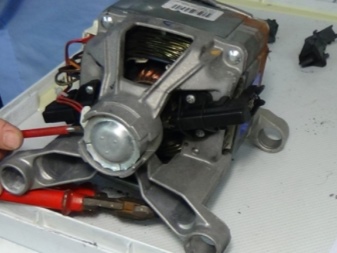
It is advisable to buy products from well-known manufacturers. Here is a list of the best firms:
- Bosch;
- Whirpool;
- Zanussi;
- Beko.
In general, it is advisable to take the brushes of the same company that made your machine. The quality of original parts is generally higher. But sometimes brushes from one manufacturer may be suitable for another manufacturer's washing machine. For example, Indesit L C00194594 carbon contact can be installed on most Indesit engines as well as Bosch, Samsung or Zanussi. Take advantage of this.
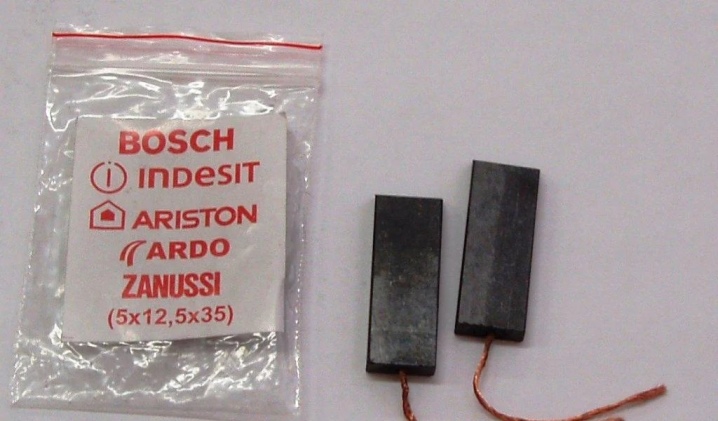
Please inspect them carefully before purchasing. If you're lucky, you can save a lot. And if not, then start a new repair after a few washings.
Here are some general tips.
- The main thing when choosing brushes is size. It is they who determine whether it is possible to put a graphite bar in the brush holder.
- The set includes 2 brushes, and they change at the same time, even if only one is worn out. This is necessary to evenly press them against the manifold and extend the life of the engine.
- Examine the part carefully. Even small cracks and chips are unacceptable. Otherwise, during work, it will quickly collapse. The surface must be smooth and matt.
- Buy spare parts only from specialized home appliance stores. There, the probability of a fake is minimal.
- Many services partner with manufacturers. You can order the necessary parts from them and, in addition, get detailed advice on repair.

Abnormal arcing of the electric motor
Sparks appear due to mechanical action of the brush and collector. This phenomenon occurs even with a serviceable engine. The brush moves along the collector, in turn forms, and then breaks the connection with the contacts. A small amount of sparks that burn is considered an acceptable phenomenon for a working unit, but if it sparks a lot, then it is necessary to diagnose the vacuum cleaner.
Incorrect angle of inclination may be the actual cause of the breakdown. Correct position: the two brushes rotate parallel to each other and along the same path. In the case of a long-term operation of the device, the brushes in it may shift, therefore it is necessary to control this process so that there are no curvatures. If pops occur, strong sparking appears, the body of the product turns black, we can talk about an inter-turn circuit.
Another reason for the malfunction is wear of parts. In this case, the vacuum cleaner is completely disassembled. Brushes create contact between special electrodes, they are components of an electric motor, so you first need to diagnose it, replace old parts and then use the technique. Some experts advise to add additional spare parts to the kit for a new product.
Poor contact between elements of technology can occur when new brushes are installed. They must be tightly fitted. The malfunction occurs in the presence of dust, in this case, regularly clean the contacts. If the contact is bad, then you can let the device work for 10 minutes at neutral speed.
Excessive stress, which is associated with high friction, creates dirt. The more carbon deposits appear, the faster the unit breaks down. Contacts must always be clean.

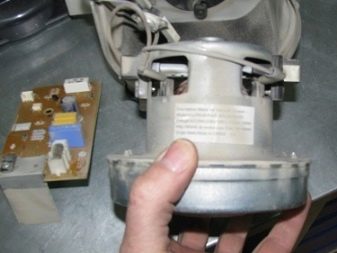
Why do the brushes sparkle at the screwdriver and what to do about it?
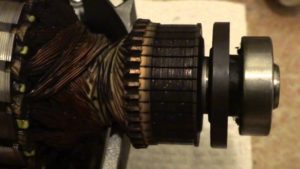
If the screwdriver sparks with rare and small sparks, this does not necessarily indicate a malfunction. A newly purchased tool can behave this way in the first 10-15 minutes of work, while the brushes are rubbing in. If enough time has passed and the sparking does not stop, it is better to return the screwdriver.
But what if the problem manifests itself after years of using the power tool and the warranty has expired long ago?
Possible reasons
the reason sparks appear even on a new engine is the mechanical interaction of the collector and brushes. Moving during tool operation from one collector contact to another, the brushes alternately create and break contact with each of them.
To make it easier to understand the principle, remember the situation when you unplug the plug of an electrical appliance from the outlet. When the circuit breaks, a spark is generated between the outlet and the plug. So it is in this case. Slight arcing is normal.
But if the sparks fly in a sheaf, this situation may be due to the following reasons:
- collector contacts in carbon;
- graphite dust from the brushes got between the contacts;
- a short circuit has occurred in the armature winding.
Collector contamination
The mechanics of collector contacts contamination are as follows: the electric motor overheats, carbon deposits settle on the collector, which creates additional friction. As a result, the engine overheats again, even when operating at low revs, the amount of carbon deposits increases, friction increases - and so on until the engine burns out at all.
The solution to the problem is obvious and consists in cleaning up contacts. Do it with the finest (zero) sandpaper:
- Remove the manifold with an anchor.
- Lightly sandpaper the contacts.
- Slide the module back into place.
It is best to clean with a lathe to avoid disturbing the geometry of the part. But in practice, you can get by with manual work.
Dust in contacts
With regular work, even at low speeds, the brushes of the screwdriver are erased. As a result, graphite dust is formed. It accumulates on the contacts of the electric motor. And since the graphite dust has its own resistance, an uneven distribution of current occurs, sparks appear, a characteristic smell - a complete feeling that the brushes are burning at the screwdriver.
If the brushes are installed correctly, they will wear out very slowly and do not lead to such problems. Take apart your instrument and see what happens there. Consider:
- the parts of the mechanism must fit tightly, without backlash;
- if a replacement was made, a brush of an inappropriate size may have been installed;
- foreign objects, dust, building chips could get into the grooves.
Gently remove dust from the brushes, from the grooves using a pointed tool. To prevent further sparking, replace or firmly reinstall all necessary parts.
For replacement, buy original parts from the manufacturer. Ultimately, this will save money and hassle.
Anchor closure
If you cleaned the collector contacts, checked the condition and tightness of the brushes, and the arcing of the electric motor continues, most likely the problem is in the armature winding.
A special device for creating an alternating magnetic field helps to detect it. If you put an anchor in it, it will start to rattle, since induced currents appear in it.
If a problem is found in this module, rewinding or completely replacing the armature will help.
Whatever the reasons for the appearance of sparks in a power tool - contamination of contacts, a short circuit in the armature or clogged brushes - they cannot be ignored. Otherwise, you can wait for the final failure of the screwdriver.
Prophylaxis
To prevent or at least minimize the risk of all these problems, follow a few simple rules:
- After work, wipe the tool and screwdriver bits that you used with a damp cloth. This will prevent dust from getting inside, on the collector contacts;
- if the resource of the screwdriver is not enough for your tasks, do not lean on it and do not press it into the surface. Purchase a tool with the appropriate power and number of revolutions;
- use original spare parts to replace broken ones.This will protect the tool from premature global breakdown.
Preventing a problem is always easier than looking for a solution later.
Drill sparks on brushes - what to do
So, your drill sparks on your brushes and you don't know what to do in such a situation. This article will tell you why this is happening, whether it needs to be fixed, and if necessary, how.
It should be noted right away that the presence of this sparking during operation is a perfectly acceptable phenomenon. This is true only if the sparks are small and there are not so many of them. If they pour in directly, then this may indicate a malfunction.
Note that on a new serviceable power tool, the brushes can also spark strongly for the first time, since they must first get used to it. Lapping usually takes 10-15 minutes of work. If after that everything remains as it was, then it is better to take the tool back to the store with a claim.
If your drill is already out of warranty, then you can try to fix everything yourself.
But first, let's describe the reasons for this phenomenon.
Why do brushes sparkle in an electric motor
Sparks, including on a serviceable engine, appear due to mechanical stress between the brushes and the collector. The brush, moving along the collector from one contact to another, alternately forms and breaks a connection with each of them. Now remember what happens if you pull out any working electrical appliance from the socket - usually at such a moment a spark jumps between the plug and the socket. In the case of a brush motor, this is the same phenomenon.
Therefore, even a small sparking is permissible even on a serviceable electric motor, since a connection and a gap constantly occur here.
Causes of severe sparking and how to eliminate them
Now let's move on to strong arcing. It occurs mainly for the following reasons:
- contamination of collector contacts with carbon deposits
- ingress of graphite dust between the collector contacts
- turn-to-turn circuit in the armature winding
Let's go through each item separately.
1) Carbon deposits are caused by overheating of the engine. The presence of carbon deposits leads to even more friction, which leads to even more rapid overheating and even more carbon formation. Which leads to a breakdown very quickly.
Excessive sparking here is obtained due to the fact that carbon deposits form additional resistance, in which the spark, when broken, turns out to be larger and more powerful.
In general, carbon deposits should be removed immediately.
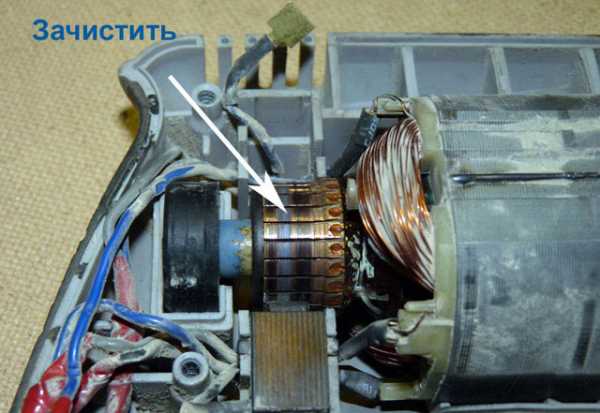
This is done with zero sandpaper. That is, it is necessary to remove the collector together with the anchor and carefully clean it. Ideally, it is desirable to carry out the cleaning on a lathe, so as not to violate the correctness of the circle. But, as a rule, this is not possible, so manual stripping can be dispensed with. The main thing is not to overdo it.
2) During the operation of the drill, the brushes are erased, due to which graphite dust is formed. It can easily accumulate between the contacts of the collector and lead to short circuits between them, since it is a conductor of electricity and has its own resistance. Because of this, the current is distributed unevenly, which leads to the appearance of large sparks in some places.
In a working drill, erasure occurs rather slowly, so the graphite dust hardly accumulates. Accordingly, its accumulation signals that the brushes are in the wrong position during operation. This usually happens when they are not close to each other in their groove, but, on the contrary, have some backlash.
This often happens when replacing brushes, when they are not selected quite suitable in size.
Therefore, when replacing this moment, you should pay close attention
Repair of such a malfunction is carried out by removing dust with a sharpened tool and replacing brushes with more suitable sizes.
3) In the event of a turn-to-turn short circuit in the armature, the current flows in a larger value to some contacts and in a smaller value to others.Because of this, in some places more current flows than necessary, as a result of which large sparks are formed.
It is necessary to deal with the identification of such a closure when the two previous points did not give much effect. It is produced on a special device that creates an alternating magnetic field. When an anchor is placed in this field, it begins to rattle, since induced currents appear in it.
Some people make such a device themselves from a power transformer, in the core of which a cut is made, where the anchor is placed.
If the reason is in the turn-to-turn circuit, then you need to rewind the winding or completely replace the armature.
These are the reasons for excessive sparking on drill brushes. Remember, if you don't do anything about it, then most likely the engine will break down soon. Therefore, do not be lazy and follow the recommendations indicated in the article.
.
How do I fix the problem?
Remove old brushes and replace with identical ones. New kits are available at most hardware stores or electrical outlets. When choosing a replacement, it is worth considering the density parameters of the graphite substance and the design features of a particular grinder. The composition and density of the brushes differ depending on the technical characteristics of the angle grinder. If these parameters do not match, the new brushes will also spark and burn.
Examine the collector for mechanical damage. If dust, dirt, sand gets on it at the time of work, scratches, dents, chips may form. Assess their degree, if any.
